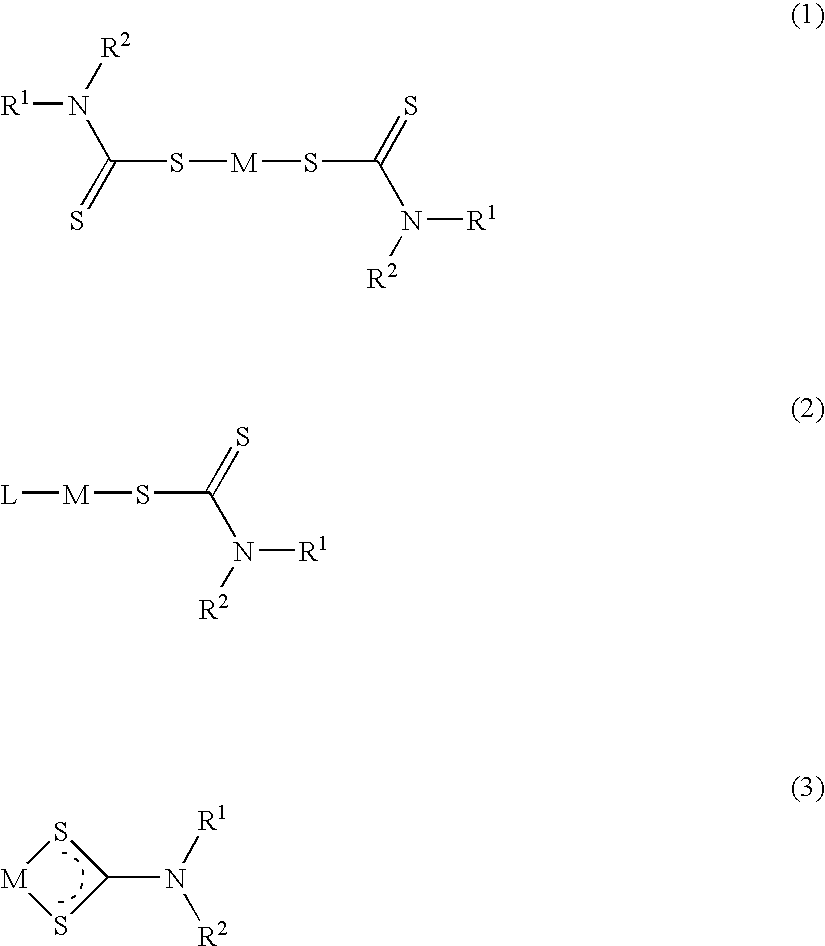Method of treating cancer using dithiocarbamate derivatives
- Summary
- Abstract
- Description
- Claims
- Application Information
AI Technical Summary
Benefits of technology
Problems solved by technology
Method used
Image
Examples
example 1
Preparation of Dichloro(diethyldithiocarbamato)gold(III) from Disulfiram and Tetrachloroauric Acid
[0520] Disulfiram (79.4 mg, 0.268 mmol) was dissolved in chloroform (10 mL) and placed in a 50 mL screw cap test tube. An aqueous solution of tetrachloroauric acid trihydrate (493.5 mg, 1.253 mmol in 15 mL water) was added to the chloroform solution. The resulting solution was vigorously mixed for five minutes. The contents of the test tube were transferred to a 30 mL test tube and the two layers separated by centrifuge. The aqueous layer was discarded and the chloroform was allowed to evaporate in a petri dish resulting in long, dark, orange-brown needles. The product was recrystallized from chloroform / acetonitrile and the final product identified to be [AuCl2(DEDTC)] by X-ray crystallography. The structure [AuCl2(DEDTC)] is shown below:
example 2
Preparation of Dichloro(diethyldithiocarbamato)gold(III) from Diethylammonium Diethyldithiocarbamate and Tetrachloroauric Acid
[0521] Diethylammonium diethyldithiocarbamate (449.2 mg, 2.020 mmol) was dissolved in water (10 mL). Tetrachloroauric acid trihydrate (775.5 mg, 1.969 mmol) was dissolved in water (10 mL). The aqueous solution of diethylammonium diethyldithiocarbamate was added to the aqueous gold(III) solution and the resulting mixture shaken for 2-3 minutes and allowed to settle. A bright yellow precipitate formed, which was separated by means of centrifuging for 10 minutes. The water was decanted and the solid separated by filtration through Whatman #2 filter paper. The precipitate was washed with water and dissolved in chloroform. Any particulate matter in the solution was removed by filtration through 0.45-μm polytetrafluoroethylene (PTFE). The resulting solution was placed in a petri dish for recrystallization. The product was characterized by means of X-ray crystallog...
example 3
Preparation of Bis(diethyldithiocarbamato)copper(II) from Diethylammonium Diethyldithiocarbamate and Copper(II) Chloride
[0522] An aqueous solution of diethylammonium diethyldithiocarbamate (450.4 mg, 2.025 mmol in 15 mL of water) was added drop-wise to an aqueous solution of copper(II) chloride dihydrate (359.5 mg, 2.109 mmol in 15 mL water) with manual stirring. A dark brown precipitate formed and the reaction mixture was shaken for 5 minutes. The precipitate was separated by filtration and washed with water. The filtrate was dissolved in chloroform and any particulate matter was removed by filtration through 0.45 μm PTFE and a portion placed in a petri dish to enable crystallization. The remaining filtrate was stored in a beaker. Crystals formed and the product, bis(diethyldithiocarbamato)copper(II), [Cu(DEDTC)2], was characterized by X-ray crystallography.
PUM
| Property | Measurement | Unit |
|---|---|---|
| Mass | aaaaa | aaaaa |
| Mass | aaaaa | aaaaa |
| Mass flow rate | aaaaa | aaaaa |
Abstract
Description
Claims
Application Information
 Login to View More
Login to View More - R&D
- Intellectual Property
- Life Sciences
- Materials
- Tech Scout
- Unparalleled Data Quality
- Higher Quality Content
- 60% Fewer Hallucinations
Browse by: Latest US Patents, China's latest patents, Technical Efficacy Thesaurus, Application Domain, Technology Topic, Popular Technical Reports.
© 2025 PatSnap. All rights reserved.Legal|Privacy policy|Modern Slavery Act Transparency Statement|Sitemap|About US| Contact US: help@patsnap.com



